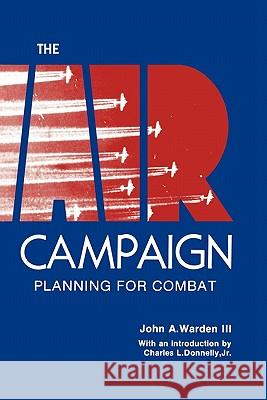The Air Campaign: Planning for Combat » książka
The Air Campaign: Planning for Combat
ISBN-13: 9781780391281 / Angielski / Miękka / 2011 / 224 str.
The Air Campaign: Planning for Combat
ISBN-13: 9781780391281 / Angielski / Miękka / 2011 / 224 str.
(netto: 91,00 VAT: 5%)
Najniższa cena z 30 dni: 95,28
ok. 16-18 dni roboczych
Dostawa w 2026 r.
Darmowa dostawa!
In the short history of air warfare, no nation with superior air forces has ever lost a war to the force of enemy arms. In itself, however, air superiority no longer guarantees victory. Planning the aerial dimension of war must of necessity explore the complicated connection between air superiority and triumph in war. "The Air Campaign: Planning for Combat" focuses on the use of air forces at the operational level in a theater of war. It draws on fascinating historical examples from World War II and the Arab-Israeli wars, stressing that the mastery of operational strategy is key to victory. It stresses the importance of using air power more effectively through mass, concentration, and economy of forces because superiority in manpower, production capacity, and technology can no longer be assumed, even by a superpower. Topics covered include: Offensive and defensive operations; Air interdiction; Close air support; Reserves; Orchestration of war; Planning the air campaign. This book offers planners a greater understanding of how to use air power for future campaigns against a wide variety of enemy capabilities in a wide variety of air operations. It confirms that the classic principles of war also apply to air combat. Air officers who want to think about air campaigns before being called upon to command or staff one, combat officers of any service involved in operations-level staff activities, and serious students of the theory and practice of air warfare will find "The Air Campaign: Planning for Combat" an invaluable resource. "
In the short history of air warfare, no nation with superior air forces has ever lost a war to the force of enemy arms. In itself, however, air superiority no longer guarantees victory. Planning the aerial dimension of war must of necessity explore the complicated connection between air superiority and triumph in war. "The Air Campaign: Planning for Combat" focuses on the use of air forces at the operational level in a theater of war. It draws on fascinating historical examples from World War II and the Arab-Israeli wars, stressing that the mastery of operational strategy is key to victory. It stresses the importance of using air power more effectively – through mass, concentration, and economy of forces – because superiority in manpower, production capacity, and technology can no longer be assumed, even by a superpower. Topics covered include: Offensive and defensive operations; Air interdiction; Close air support; Reserves; Orchestration of war; Planning the air campaign. This book offers planners a greater understanding of how to use air power for future campaigns against a wide variety of enemy capabilities in a wide variety of air operations. It confirms that the classic principles of war also apply to air combat. Air officers who want to think about air campaigns before being called upon to command or staff one, combat officers of any service involved in operations-level staff activities, and serious students of the theory and practice of air warfare will find "The Air Campaign: Planning for Combat" an invaluable resource.











